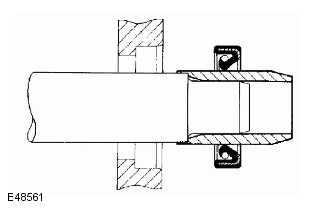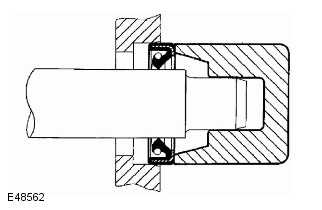Land Rover Defender: Electrical Precautions
GENERAL
The following guidelines are intended to make sure the safety of the operator whilst preventing damage to the electrical and electronic components of this vehicle.
EQUIPMENT
Prior to commencing any test procedure on the vehicle, make sure that the relevant test equipment is working correctly and that any harness or connectors are in good condition. It is particularly important to check the condition of all plugs and leads of mains operated equipment.
POLARITY
Never reverse connect the vehicle battery and always make sure the correct polarity when connecting test equipment.
HIGH VOLTAGE CIRCUITS
Whenever disconnecting live ht circuits, always use insulated pliers and never allow the open end of the ht lead to contact other components, particularly ECU's.
VEHICLES INSTALLED WITH NAVIGATION
CAUTION: The following precaution must be observed as failure to comply may result in damage to the navigation system computer hardware.
A minimum period of two minutes must have elapsed from the ignition being switched to the 'OFF' position prior to disconnection of the battery.
VEHICLES WITH BI-XENON HEADLAMP BULBS INSTALLED
WARNING: The following precautions must be observed as failure to comply may result in exposure to ultra-violet rays, severe electric shock, burns or risk of an explosion.
- Safety goggles and gloves must be worn.
- Make sure that headlamps are switched off before removing bulbs.
- Do not touch the glass portion of the bulb.
- On no account should headlamps be switched on with the bulb removed from the headlamp.
- Bulb testing may only be carried out with the bulb installed in the headlamp.
- Bulbs must be disposed of in accordance with the local authority bye-laws.
CONNECTORS AND HARNESSES
The engine compartment of a vehicle is a particularly hostile environment for electrical components and connectors.
Always observe the following:
- Make sure electrically related items are dry and oil free before disconnecting/connecting test equipment.
- Make sure that disconnected electrical connectors and sensors are protected from any possible oil, coolant or other liquid contamination. Any such contamination could impair performance or lead to component failure.
- Never force connectors apart or pull on the wiring harness.
- Always make sure locking tabs are disengaged before disconnecting electrical connectors etc. and make sure that correct orientation is achieved before connection.
- Make sure that any protection covers, insulation etc. are replaced if disturbed.
Having confirmed that a component is faulty, carry out the following:
- Switch off the ignition and disconnect the battery.
- Remove the component and support the disconnected harness.
- When replacing electrical components, keep oily hands away from electrical connections and make sure that locking tabs on connectors are fully engaged.
BATTERY DISCONNECTION/CONNECTION
Always refer to the Electrical Section of this manual - Battery Disconnect/Connect prior to attempting to connect or disconnect the battery.
FUEL HANDLING PRECAUTIONS
The following information lists basic precautions which must be observed if fuel is to be handled safely. It also outlines other areas of risk which must not be ignored. As this information is issued for basic guidance only, consult your local Fire Department where any doubt as to personal and environmental safety exists - See also Health and Safety Precautions.
General precautions
Always have the correct type of fire extinguisher containing Foam, CO2, Gas or powder accessible when handling or draining fuel or dismantling fuel systems. Fire extinguishers must also be located in areas where fuel is stored.
Make sure that suitable warning signs are exhibited.
Keep all sources of ignition well away from areas where fuel is being handled.
Make sure that any lead lamps are flameproof and kept clear of spillage.
WARNINGS: Do not disassemble or reassemble fuel system components whilst vehicle is over a pit.
No one should be permitted to repair components associated with fuel without first having specialist training.
Always disconnect the vehicle battery before carrying out disassembly, reassembly or draining work on a fuel system.
Fuel tank and system draining
Draining must be carried out in accordance with the procedures given in the relevant Fuel System section of this manual.
WARNINGS:
- Never drain fuel or work on a fuel system while the vehicle is over a pit. Extraction or draining of fuel must be carried out in a well ventilated area.
- Never switch on or operate mobile (cellular) phones in the vicinity of vehicles when operations are being carried out on the fuel system.
- Always attach fuel vapor warning labels to fuel tanks immediately after draining.
- Containers used for storing fuel must be clearly marked with the contents and placed in a safe storage area which meets the requirements of the local authority.
CAUTION: Some fuel lines are now installed with 'quick release' connectors. If a connector is damaged, no attempt must be made to repair the connector, a new fuel line and connector(s) assembly must be installed.
Always release pipe clips fully before attempting to disconnect fuel pipes.
FUEL TANK REPAIRS
CAUTION: No attempt should be made to repair a plastic fuel tank. If the structure of the tank is damaged, a new tank must be installed.
OIL SEALS
Never use a seal which has been improperly stored or handled.
- Take great care when removing old seals that the sealing surfaces and seal housing are not damaged.
- Carefully examine seal before installation to make sure that it is clean and undamaged.
- Make sure that the surface on which the seal is to run and also the seal housing is clean and free from burrs or scratches. Renew the component if the sealing surface cannot be restored.
- Special tools and protection sleeves are provided for installing the majority of seals and must be used when specified.
- Many seals are now coated with a protective wax and DO NOT need to be lubricated prior to installation. Always check the relevant repair procedure which will state if a seal must be installed dry.
- Never touch these seals with
oily hands as the oil will contaminate the protective coating and affect the
sealing properties of the seal; also, make
sure that installation tools and protection sleeves are free from oil and
grease. Seals which must be lubricated prior
to installation should have the recommended lubricant applied to the areas
specified in the repair procedure.
Make sure that a seal is installed the correct way round. For example, the lip of the seal must face towards the lubricant which it is sealing.
- When installing an oil seal, make sure that it is positioned square to shaft and housing. Where the seal is to be installed to a housing prior to installing over a shaft, take care not to allow the weight of an unsupported shaft to rest on the seal.

- Always use the recommended special tool and protection sleeve to install an oil seal. If no tool is specified, use a suitable mandrel approximately 0.4 mm (0.015 in) smaller than the outside diameter of the seal. Use adhesive tape on the shaft to protect the sealing lip of the seal.

- Press or drift the seal in to the depth of its housing if the housing is shouldered or flush with the face of the housing where no shoulder is provided. Make sure that the seal is not tilted in the housing when it is installed.

